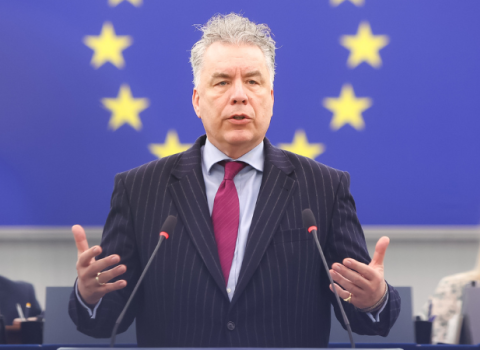With defence spending rising, Europe needs to prioritise finding better ways to promote related innovation
Said D. Werner
Germany, Europe’s largest economy, is set to increase its defence budget, according to the government's latest draft law. Yet the record-breaking €53 billion proposed is still less than 7% of the nearly €830 billion of the US defense budget.
For the Eurozone as a whole, with its population of 449 million, the European Defence Agency recently reported €240 billion in defence spending. For comparison, California, a state with less than 9% of the EU's population - and free from geopolitical threats – had a defence budget of $56.2 billion in 2022.
However, the full scope of the disparity only becomes apparent when making a broader comparison. In 2023, NATO's cumulative budget reached an all-time high of $1.35 trillion. Yet, adjusted for global purchasing power parity, it was only at the level of 2002, when the alliance first agreed to its 2% GDP target. In the last fiscal year, that target was reached was by only 11 out of 32 NATO member states, leaving an $80 billion shortfall.
With Russia and China increasing their relative spending, the pressure on NATO is immense. Upgrades for equipment, critical infrastructure protection, aid for Ukraine, multilateral operations, and green technologies are not free. Optimistically, the investment requirement is at least $570 billion. German finance minister Christian Lindner hopes that future GDP growth will naturally lead to enhanced defence capabilities, but economists would dismiss this as vanity metrics.
Money isn't everything. In the US, it is common practice not to politicise national security, considering it as part of the national strategic culture. In Europe, the situation is different, given a foreign policy that has long relied on the perception that most European countries are surrounded by friends, as former German President Joachim Gauck self-critically pointed out during the 2014 Munich Security Conference opening address.
To this day, the EU’s security policy priorities seem somewhat unresolved. At least within the defence alliance, some progress has been made. Through the $1.1 billion NATO Innovation Fund (NIF), 24 member states, including 20 EU members, are fostering several promising deep-tech companies.
These potential innovation leaders require time- and cost-intensive research and development phases, with growth patterns that fluctuate like dolphins leaping in and out of the water, unlike the steady upward trajectory of high-tech unicorns. However, deep-tech ventures often have both civilian and military applications—an observation underscored by the war in Ukraine, where commercial drones and communication systems quickly provided tactical advantages. Between 2018 and 2022, deep-tech investments in NIF portfolio states increased by 23%.
To fully harness this GDP potential, the EU needs to create the right conditions. A first step was taken in this direction in 2022, with the New European Innovation Agenda, which includes measures for access to finance and the creation of innovation ecosystems to foster and retain talent.
However, creating a unified European deep-tech ecosystem remains challenging. As is often the case, Europe’s strategies for technological innovation are somewhat fragmented. This is exemplified by the AI Act, hailed by most EU MEPs as the first mature regulation. But in regulating a technology still in its infancy, the continent risks falling behind. According to the traffic light risk system implemented by the Act, foundation models could be considered high-risk per se, regardless of whether they explain legal texts or analyse vast amounts of data from surveillance drones.
Liability risks and additional costs mainly affect AI start-ups. Under the current regulations, the AI-supported defence sector will almost certainly fall into the high-risk category. The danger is that more and more innovative start-ups will relocate. This would be a problem not only for the already significant brain drain and skilled labour shortages, but also for acquisitions of innovative non-European companies by European corporations, such as the acquisition of Israeli cybersecurity specialist XM Cyber by Germany’s Schwarz Group, which could become unattractive in the future due to rising costs in risk assessment.
To avoid such opportunity costs, EU technology strategists must adapt to the geopolitical change that is in motion. In line with the US Department of Defense Office of Strategic Capital, the EU member state ministries of defence should streamline their pivotal role in dual-use funding and seriously consider innovation quotas for start-ups in their procurement policies. They should also establish regulatory sandboxes for AI-based defence applications. These would be critical details in the debate about links between the EU's technology strategy and its defence capabilities. Yet, it’s worth noting that whoever sits in the Oval Office in 2025 is unlikely to care about this. In geopolitics, it’s all the narrative — and the money.
While astute observers like venture capitalist Herbert Mangesius, founding partner of Vsquared, have suggested that the potential re-election of Donald Trump has already spurred EU investments in the defence sector, the US still leads in both domains.
However, the budget faces tough challenges in the capital market, with interest costs of nearly 4% for ten-year government bonds. EU bonds are about a whole percentage point lower. Debt prioritised for the defence budget would thus be significantly cheaper. However, unlike the US federal government, the EU is not a state and does not control a unified fiscal and monetary policy.
Simply put: the EU’s budget sovereignty is dictated by 27 states with vastly different economic outputs. Europe’s decentralised financing was intensively debated during the Euro crisis. Germany and the Netherlands, which enjoy low borrowing rates in the capital markets, strongly resisted a European debt mechanism at the time, fearing that highly indebted countries would benefit from the higher creditworthiness of economically stronger states, without implementing necessary economic reforms. This argument remains valid in the European internal market. That said, another reality is that the EU is no longer surrounded by friendly neighbours. As a result, the defence budgets of many EU states have grown since the war and are expected to rise further.
Next to Ukraine, the external effects of Russia’s war of aggression are felt most strongly by states including Estonia, Hungary, Lithuania, Norway, Poland, Romania, Slovakia, and Turkey. The problem is that these countries face significant burdens in making the necessary investments, with yield rates on 10-year bonds sometimes well over 3%. In the event of a conflict involving the alliance, these states form NATO’s geographical first line of defence, so there is no need for a renewed debate about Eurobonds in Europe. This priority squarely falls within NATO’s remit.
The establishment of the NATO Innovation Fund is a testament to the readiness of many allies to enhance and fortify cross-domain cooperation.
What NATO lacks is a centralised financing entity. The provision of loans is just one part of the equation. In the face of mounting geopolitical trade constraints, the structural promotion of internal trade among allies is another significant aspect that should be addressed. To achieve this, a comprehensive concept needs to be developed and politically prioritised by the allies, especially the EU.
Prioritisation in the face of uncertain scenarios is one of the most complex issues of strategic management. Strategic planning is about what endures beyond five years. With NATO celebrating 75 years, Europe awaits still its ‘Eureka moment’. The new Commission should step up to the plate.
Said D. Werner is co-founder and affiliate project lead at the MIT Murray Lab for Deep Tech & Geopolitics. He advises governments, foundations, companies, and political parties on strategic affairs.





 A unique international forum for public research organisations and companies to connect their external engagement with strategic interests around their R&D system.
A unique international forum for public research organisations and companies to connect their external engagement with strategic interests around their R&D system.